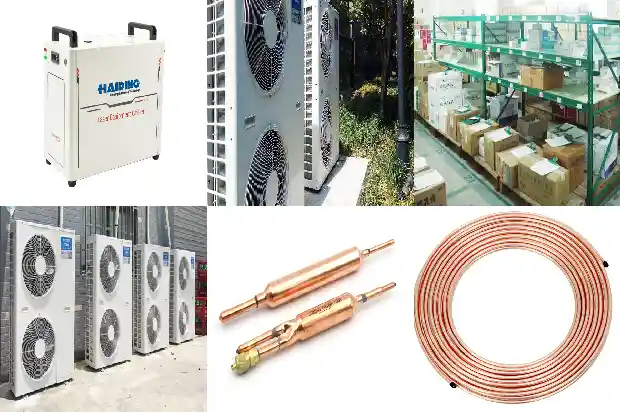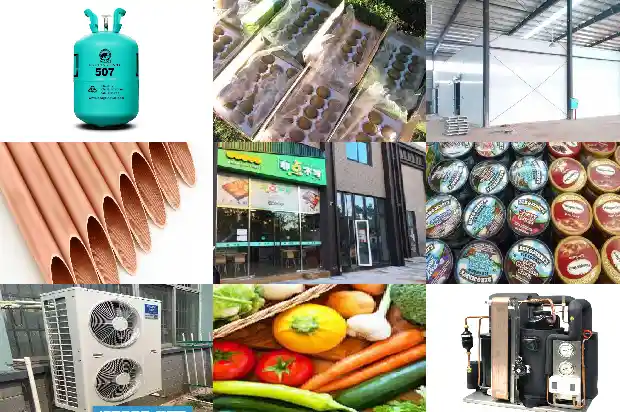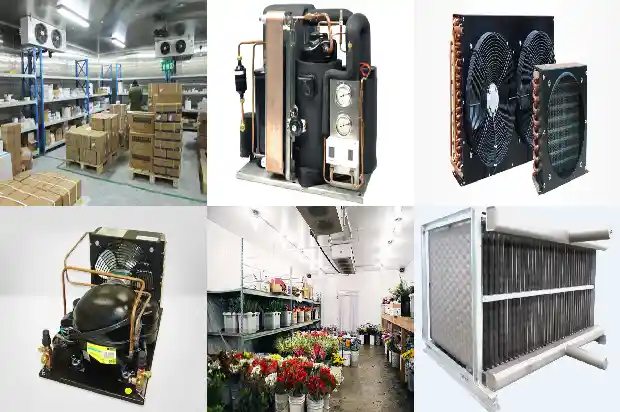How to troubleshoot dirty blockage, ice blockage and oil blockage in refrigeration systems?
2024-09-21
I. Three types of "blockage" faults in refrigeration systems:
Regarding blockages in refrigeration systems, we can generally divide them into three major categories: ice blockage, dirty blockage (also known as fouling blockage), and oil blockage. Among them, dirty blockage and oil blockage are further divided into two types: completely blocked and slightly blocked.
Regarding blockages in refrigeration systems, we can generally divide them into three major categories: ice blockage, dirty blockage (also known as fouling blockage), and oil blockage. Among them, dirty blockage and oil blockage are further divided into two types: completely blocked and slightly blocked.
II. Analysis of causes of blockages in refrigeration systems:
Causes of blockage:
Ice blockage: Due to the moisture in the system exceeding the allowable value.
Dirty blockage: Excessive impurities, such as residual dirt in the system during the manufacturing of refrigeration equipment, shedding of metal oxides in pipelines, molecular sieve or silica gel powder, dirt accidentally introduced during maintenance, etc., blocking pipelines or pipelines being deformed under pressure (bad blockage).
Oil blockage: Excessive filling of refrigerant oil and deterioration accumulate in pipeline bends, smaller diameter sections or the refrigerant oil becomes sticky when cooled at the capillary tube, or excessive adhesion of refrigerant oil on the inner wall of the pipeline due to long service time (oil blockage), causing system blockage.
Causes of blockage:
Ice blockage: Due to the moisture in the system exceeding the allowable value.
Dirty blockage: Excessive impurities, such as residual dirt in the system during the manufacturing of refrigeration equipment, shedding of metal oxides in pipelines, molecular sieve or silica gel powder, dirt accidentally introduced during maintenance, etc., blocking pipelines or pipelines being deformed under pressure (bad blockage).
Oil blockage: Excessive filling of refrigerant oil and deterioration accumulate in pipeline bends, smaller diameter sections or the refrigerant oil becomes sticky when cooled at the capillary tube, or excessive adhesion of refrigerant oil on the inner wall of the pipeline due to long service time (oil blockage), causing system blockage.
III. Fault phenomena and identification of blockage categories:
Common characteristics: The condenser is not hot or not hot enough, the evaporator does not frost or only partially frosts, there is no sound of refrigerant flow or the sound is small, the low-pressure is low or in a negative pressure state, while the high-pressure is high (the difference from insufficient refrigerant); the working current is smaller than the normal value.
Individual characteristics:
A. Ice blockage: There is a phenomenon of "intermittent repetitive refrigeration or periodic non-refrigeration".
B. Dirty blockage, bad blockage, and oil blockage: Different from ice blockage, there will be no "intermittent repetitive refrigeration" phenomenon. Once blocked, it cannot refrigerate or the refrigeration effect is poor.
Method to determine whether it is dirty blockage or oil blockage: In a system with capillary throttling, cut the capillary tube 0.5 cm away from the drying filter.
01. If there is no refrigerant spraying out, then cut open the other end of the drying filter. If there is still no refrigerant spraying out, then it is a complete leakage of refrigerant.
02. If the refrigerant sprayed out after cutting the capillary tube is mixed with a lot of refrigerant oil, then it is oil blockage at the capillary tube.
03. If there is refrigerant spraying out and there is not much oil, it can be determined that a dirty blockage fault has occurred at the capillary tube.
In a system with expansion valve throttling, first recover the refrigerant, then remove the filter screen and solenoid valve at the inlet of the expansion valve, clean and dry with gasoline and reinstall. At the same time, replace the drying filter. If the test run is normal, it is dirty blockage; if it is still blocked, it is oil blockage or bad blockage.
The location of oil blockage is generally at the sinking part of pipeline bends and low-temperature and low-pressure pipelines (such as evaporator and other parts). The location of bad blockage is generally at filters, solenoid valves, capillary tubes, expansion valves, and dead bends and deformed parts of pipelines. Generally, there will be frosting or condensation at the blocked part.
C. Slight blockage: The evaporator takes a long time to be fully frosted or cannot be fully frosted.
Distinguishing characteristics of different blockages:
01. Unique characteristic of drying filter blockage: Condensation or frosting occurs on the capillary tube. This is because the filter acts as a throttle, and the capillary tube is equivalent to an evaporator - absorbing heat and condensing.
02. Important distinguishing characteristics between air in refrigerant and excessive refrigerant:
a. The upper part of the high-pressure pipe and condenser is very hot, while the lower part is obviously not hot.
b. Sometimes ice beads appear at the outlet of the capillary tube.
c. The evaporator shows periodic frosting.
d. When the refrigeration system is running, the high-pressure gauge pointer connected to the high-pressure side swings left and right with a slightly larger amplitude and is unstable; at the same time, the pressure gauge pointer swings quickly, and the swing is the same frequency as the piston movement.
e. The external unit vibrates more than a normal unit because air is incompressible.
Common characteristics: The condenser is not hot or not hot enough, the evaporator does not frost or only partially frosts, there is no sound of refrigerant flow or the sound is small, the low-pressure is low or in a negative pressure state, while the high-pressure is high (the difference from insufficient refrigerant); the working current is smaller than the normal value.
Individual characteristics:
A. Ice blockage: There is a phenomenon of "intermittent repetitive refrigeration or periodic non-refrigeration".
B. Dirty blockage, bad blockage, and oil blockage: Different from ice blockage, there will be no "intermittent repetitive refrigeration" phenomenon. Once blocked, it cannot refrigerate or the refrigeration effect is poor.
Method to determine whether it is dirty blockage or oil blockage: In a system with capillary throttling, cut the capillary tube 0.5 cm away from the drying filter.
01. If there is no refrigerant spraying out, then cut open the other end of the drying filter. If there is still no refrigerant spraying out, then it is a complete leakage of refrigerant.
02. If the refrigerant sprayed out after cutting the capillary tube is mixed with a lot of refrigerant oil, then it is oil blockage at the capillary tube.
03. If there is refrigerant spraying out and there is not much oil, it can be determined that a dirty blockage fault has occurred at the capillary tube.
In a system with expansion valve throttling, first recover the refrigerant, then remove the filter screen and solenoid valve at the inlet of the expansion valve, clean and dry with gasoline and reinstall. At the same time, replace the drying filter. If the test run is normal, it is dirty blockage; if it is still blocked, it is oil blockage or bad blockage.
The location of oil blockage is generally at the sinking part of pipeline bends and low-temperature and low-pressure pipelines (such as evaporator and other parts). The location of bad blockage is generally at filters, solenoid valves, capillary tubes, expansion valves, and dead bends and deformed parts of pipelines. Generally, there will be frosting or condensation at the blocked part.
C. Slight blockage: The evaporator takes a long time to be fully frosted or cannot be fully frosted.

Distinguishing characteristics of different blockages:
01. Unique characteristic of drying filter blockage: Condensation or frosting occurs on the capillary tube. This is because the filter acts as a throttle, and the capillary tube is equivalent to an evaporator - absorbing heat and condensing.
02. Important distinguishing characteristics between air in refrigerant and excessive refrigerant:
a. The upper part of the high-pressure pipe and condenser is very hot, while the lower part is obviously not hot.
b. Sometimes ice beads appear at the outlet of the capillary tube.
c. The evaporator shows periodic frosting.
d. When the refrigeration system is running, the high-pressure gauge pointer connected to the high-pressure side swings left and right with a slightly larger amplitude and is unstable; at the same time, the pressure gauge pointer swings quickly, and the swing is the same frequency as the piston movement.
e. The external unit vibrates more than a normal unit because air is incompressible.

IV. Elimination methods
(1) Ice blockage:
A. Heating and vacuuming method (also known as exhaust baking method):
While evacuating the system, heat and raise the temperature of components such as the compressor, condenser, drying filter, and evaporator. It is best to use a vacuum pump with a flow rate of 2 to 4 liters/second for vacuuming. This vacuuming effect is better. The vacuuming time is generally about 4 hours.
B. Flushing with fluorine and nitrogen gas method (also known as fluorine and nitrogen gas dehydration method):
After evacuating the system, charge the system with a certain pressure of refrigerant or dry nitrogen gas. Then start the compressor for 5 to 10 minutes. Then release the fluorine or nitrogen gas that has absorbed some moisture in the system. Repeat this two or three times to remove moisture.
C. Secondary drying filter water absorption method:
In the connection between the conventional drying filter and the capillary tube, weld and pull out the outlet end of the capillary tube (the inlet end of the evaporator). Then insert it into the inlet end of another added drying filter and weld it well. Then weld the outlet end of the drying filter to the inlet end of the evaporator.
This has better water absorption effect than the conventional single drying filter and can completely eliminate ice blockage faults.
(2) Dirty blockage:
Dirty blockage mostly occurs at parts such as capillary tubes (or expansion valves), drying filters, and liquid outlet valves. After the drying filter is blocked, it should be replaced. The expansion valve can be disassembled and cleaned if it is blocked. If the capillary tube is inconvenient to replace, it can be flushed with nitrogen gas with a pressure of about 1 MPa. The nitrogen gas should be flushed in the opposite direction of the refrigerant flow (i.e., enter from the return gas pipe end and then be released from the condenser outlet or capillary tube). During the flushing process, press and release the exhaust port by hand to increase the flushing force on the capillary tube.
(3) Oil blockage:
First weld open the pipeline and bake each welding joint with a neutral flame. Pull out the low-pressure suction pipe, process pipe, and the welding joint of the drying filter after baking. Then start the compressor and bake the high-pressure exhaust pipe and condenser with a low-temperature flame (starting from the end connected to the compressor). Use the high-pressure gas discharged by the compressor to discharge the frozen oil vaporized by baking until all the remaining oil in the condenser is removed. For oil blockage in the evaporator, the evaporator can be removed together with the low-pressure pipe and capillary tube. Then connect the low-pressure pipe to the nitrogen cylinder and flush and bake the low-pressure pipe, evaporator, and capillary tube with pressure nitrogen gas to flush out the remaining oil.
If the evaporator cannot be removed, the low-pressure pipe at the compressor end can also be welded off. Start the compressor and block the low-pressure pipe opening with your hand. When it feels that it cannot be blocked, suddenly release your hand to allow the oil to be discharged with the gas. Repeat this spraying several times.
(1) Ice blockage:
A. Heating and vacuuming method (also known as exhaust baking method):
While evacuating the system, heat and raise the temperature of components such as the compressor, condenser, drying filter, and evaporator. It is best to use a vacuum pump with a flow rate of 2 to 4 liters/second for vacuuming. This vacuuming effect is better. The vacuuming time is generally about 4 hours.
B. Flushing with fluorine and nitrogen gas method (also known as fluorine and nitrogen gas dehydration method):
After evacuating the system, charge the system with a certain pressure of refrigerant or dry nitrogen gas. Then start the compressor for 5 to 10 minutes. Then release the fluorine or nitrogen gas that has absorbed some moisture in the system. Repeat this two or three times to remove moisture.
C. Secondary drying filter water absorption method:
In the connection between the conventional drying filter and the capillary tube, weld and pull out the outlet end of the capillary tube (the inlet end of the evaporator). Then insert it into the inlet end of another added drying filter and weld it well. Then weld the outlet end of the drying filter to the inlet end of the evaporator.
This has better water absorption effect than the conventional single drying filter and can completely eliminate ice blockage faults.

(2) Dirty blockage:
Dirty blockage mostly occurs at parts such as capillary tubes (or expansion valves), drying filters, and liquid outlet valves. After the drying filter is blocked, it should be replaced. The expansion valve can be disassembled and cleaned if it is blocked. If the capillary tube is inconvenient to replace, it can be flushed with nitrogen gas with a pressure of about 1 MPa. The nitrogen gas should be flushed in the opposite direction of the refrigerant flow (i.e., enter from the return gas pipe end and then be released from the condenser outlet or capillary tube). During the flushing process, press and release the exhaust port by hand to increase the flushing force on the capillary tube.
(3) Oil blockage:
First weld open the pipeline and bake each welding joint with a neutral flame. Pull out the low-pressure suction pipe, process pipe, and the welding joint of the drying filter after baking. Then start the compressor and bake the high-pressure exhaust pipe and condenser with a low-temperature flame (starting from the end connected to the compressor). Use the high-pressure gas discharged by the compressor to discharge the frozen oil vaporized by baking until all the remaining oil in the condenser is removed. For oil blockage in the evaporator, the evaporator can be removed together with the low-pressure pipe and capillary tube. Then connect the low-pressure pipe to the nitrogen cylinder and flush and bake the low-pressure pipe, evaporator, and capillary tube with pressure nitrogen gas to flush out the remaining oil.

If the evaporator cannot be removed, the low-pressure pipe at the compressor end can also be welded off. Start the compressor and block the low-pressure pipe opening with your hand. When it feels that it cannot be blocked, suddenly release your hand to allow the oil to be discharged with the gas. Repeat this spraying several times.
Related Articles
- Refrigeration System Failures: Handling System Blockages and Water Infiltration
- Freezing Chamber System Blockage, Dirty Blockage, and Oil Blockage Characteristics and Treatment Methods
- How to Handle Blockages in Refrigeration Equipment
- Common Pressure Valves and Protection Devices in Refrigeration Units
- Analysis of Seven Reasons for Ice Formation in Computer Room Air Conditioners
- Cleaning Methods for Different Types of Condensers in Refrigeration Devices
- Safety Protection in Refrigeration Devices
- On the maintenance and inspection of external insulation layers of pipes in refrigeration devices
- Has Your Refrigeration System Experienced "Oil Carry - over"?
- Causes and Prevention of "Primary Condensation" and "Secondary Condensation" in Fan - Coil Units
- Common Faults of HVAC Fan Coil Units
- Introduction to Oil Collector in Refrigeration System
- Forms of Oil Separators
- Installation and Oil Return Precautions for Refrigeration Equipment Pipelines
- Precautions for Replacing Refrigeration Compressor Refrigerant Oil
- What are the reasons for the poor oil return of screw compressors?
- Oil Cooling Methods and Oil Leakage Operations for Screw Compressors
- Have You Encountered the Three Common Problems of Refrigeration Compressors?
